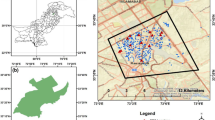Abstract
Extensive groundwater withdrawals in urban areas may cause water shortages, land subsidence, and water quality problems. The Quetta Valley is the largest population center in Balochistan province in western Pakistan. This area is arid and groundwater is the main water source for domestic and agricultural use. This work presents global positioning system (GPS) data and assessment of spatial and temporal variations in water levels. GPS data from two stations from mid-2006 to the beginning of 2009 show subsidence rate of 10 cm\year. Nine satellite images from 1975 to 2009 were classified and processed to quantify land cover and land use changes, which highlight an increase in agricultural areas in the central region of the Quetta Valley, as well as reduced vegetation on mountains. These data correspond to gradual temporal changes in water volumes in streams and lakes. Average temperatures have also increased and mean precipitation has decreased during this period. However, the greatest change in this area has been in population growth, which rose from 260,000 in 1975 to 1.2 million in 2010, mainly due to migration of refugees from war-torn neighboring Afghanistan. The Quetta Valley provides a good example for studying the impact of urbanization on water resources.







Similar content being viewed by others
References
BBWR (1996) Groundwater level monitoring studies in Pishin sub-basin. Balochistan Bureau of Water Resources. Department of Irrigation and Power, Government of Balochistan, Balochistan
BIPD (Balochistan Irrigation and Power Department) (2010) Groundwater management plan for Quetta sub-basin
Engelkemeir R, Khan SD, Burke K (2010) Surface deformation in Houston. Texas using GPS. Tectonophysics 490(1–2):47–54
Galloway D, Jones DR, Ingebritsen SS (1999) Land subsidence in the United States. USGS Circular 1182
GOPC (Government of Pakistan, Census) (1998) Population census of Pakistan. Population Census Division, Government of Pakistan
Hayashi T, Tokunagga T, Aichi M, Shimada J, Taniguchi M (2009) Effects of human activities and urbanization on groundwater environments: an example from the aquifer system of Tokyo and the surrounding area. Sci Total Environ 407:3165–3172
IGES (Institute for Global Environmental Strategies) (2007) Sustainable groundwater management in Asian cities: A final report of Research on Sustainable Water Management Policy
IPCC (Intergovernmental Panel on Climate Change) (2007) Climate change 2007: Synthesis Report, Summary for Policymakers. IPCC Plenary XXVII, Valencia, Spain, pp 12–17
Kazmi AH, Abbas G, Younas S (2005) Water resources and hydrogeology of Quetta Basin, Balochistan, Pakistan. Geological Survey of Pakistan, Quetta
Khan SD (2005) Urban Development and flooding in Houston Texas, inferences from remote sensing data using neural network technique. Environ Geol 47(8):1120–1127
Khan SD, Mahmood K, Sultan MI, Khan AS, Xiong Y, Sagintayev Z (2010) Trace element geochemistry of groundwater from Quetta Valley, western Pakistan. J Environ Earth Sci 60:573–582
King RW, Bock Y (2002) Documentation for GAMIT Analysis Software, Release 10.0. Massachusetts Institute of Technology Cambridge
Lands berg HE (1981) The urban climate. Academic Press, New York
Lubis AM, Sato T, Tomiyama N, Isezaki N, Yamanokuchi T (2011) Ground subsidence in Semarang-Indonesia investigated by ALOS–PALSAR satellite SAR interferometry. J Asian Earth Sci 40:1079–1088
NGI and SCI (1997) Feasibility study on irrigation water resources development with delay action dams project in Balochsitan in the Islamic Republic of Pakistan—IPD, JICA
Nguyen L, Khan SD, Sultan M (2007) Finding causes of groundwater fluctuations in Quetta basin, Pakistan. Geol Soc Am Abstr Progr 39(6):323
NUPE (2003) Groundwater and its susceptibility to degradation; NUPE/DEWA/RS.03-3
Oldham RD (1892) Subrecent and recent deposits of t/te aalleT ptains of Quetta, Pishin and the Dasht-i-Bedaolat; with appendices on the Chamans of Qtetta; and the Artesian water supply of Quetta and Pishin. Rec Geol Surv lndia XXV:36–53
PMD. Pakistan Meteorological Department (2010) Climate Data: Daily Temperature in Balochistan in Climate Data Processing Centre, Quetta. http://pakmet.com.pk
WAPDA (Water and Power Development Authority) (2001) Individual Basinal Reports of Balochistan, Hydrogeology Project, Quetta, 1982–2000, Pakistan. Water and Power Development Authority, Pakistan
Yin Y, Zhang K, Li X (2006) Urbanization and land subsidence in China The Geological Society of London. IAEG2006, paper number 31
Acknowledgments
This work was funded by grants from US-AID and Pakistan Higher Education Commission. ASK thanks Water and Sanitation Authority, Quetta and Pakistan Metrological Department for providing the data. DMK thanks the financial contribution of the Pakistan Science Foundation for the GPS survey and Dr. Roger Bilham and Dr. Walter Szeliga from University of Colorado for data processing.
Author information
Authors and Affiliations
Corresponding author
Rights and permissions
About this article
Cite this article
Khan, A.S., Khan, S.D. & Kakar, D.M. Land subsidence and declining water resources in Quetta Valley, Pakistan. Environ Earth Sci 70, 2719–2727 (2013). https://doi.org/10.1007/s12665-013-2328-9
Received:
Accepted:
Published:
Issue Date:
DOI: https://doi.org/10.1007/s12665-013-2328-9




